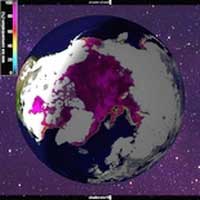 |
|
Global warming is causing a reduction in Arctic ice extent (Photo: University of Illinois/VNN) |
According to a report by NASA (National Aeronautics and Space Administration) published on January 24, 2005, the year 2005 was recorded as the hottest year for Earth’s climate, marking an unusually warm period in the Arctic region.
Analysis from NASA’s Goddard Space Flight Center indicated that the five hottest years since the new temperature measurement system was implemented in the 1980s all occurred within the last decade.
In order of temperature, the years with the highest average annual temperatures are 2005, 1998, 2002, 2003, and 2004.
Scientists previously considered 1998 the hottest year due to the frequent occurrence of the El Niño climate phenomenon.
However, according to NASA, the climate in 2005 exceeded that of 1998 despite the absence of an El Niño event.
Notably, temperatures in the Arctic region have also risen unusually. To determine whether our “home” Earth is warming or cooling, scientists utilize data from land-based weather stations, satellite measurements of sea surface temperatures since 1982, and data from maritime vessels from prior years.

















































